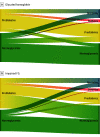Risk of Progression to Diabetes Among Older Adults With Prediabetes
- PMID: 33555311
- PMCID: PMC7871207
- DOI: 10.1001/jamainternmed.2020.8774
Risk of Progression to Diabetes Among Older Adults With Prediabetes
Erratum in
-
Errors in Data Presentation in Text, Table, and Supplement.JAMA Intern Med. 2021 Apr 1;181(4):570. doi: 10.1001/jamainternmed.2021.1321. JAMA Intern Med. 2021. PMID: 33818604 Free PMC article. No abstract available.
Abstract
Importance: The term prediabetes is used to identify individuals at increased risk for diabetes. However, the natural history of prediabetes in older age is not well characterized.
Objectives: To compare different prediabetes definitions and characterize the risks of prediabetes and diabetes among older adults in a community-based setting.
Design, setting, and participants: In this prospective cohort analysis of 3412 older adults without diabetes from the Atherosclerosis Risk in Communities Study (baseline, 2011-2013), participants were contacted semiannually through December 31, 2017, and attended a follow-up visit between January 1, 2016, and December 31, 2017 (median [range] follow-up, 5.0 [0.1-6.5] years).
Exposures: Prediabetes defined by a glycated hemoglobin (HbA1c) level of 5.7% to 6.4%, impaired fasting glucose (IFG) level (FG level of 100-125 mg/dL), either, or both.
Main outcomes and measures: Incident total diabetes (physician diagnosis, glucose-lowering medication use, HbA1c level ≥6.5%, or FG level ≥126 mg/dL).
Results: A total of 3412 participants without diabetes (mean [SD] age, 75.6 [5.2] years; 2040 [60%] female; and 572 [17%] Black) attended visit 5 (2011-2013, baseline). Of the 3412 participants at baseline, a total of 2497 participants attended the follow-up visit or died. During the 6.5-year follow-up period, there were 156 incident total diabetes cases (118 diagnosed) and 434 deaths. A total of 1490 participants (44%) had HbA1c levels of 5.7% to 6.4%, 1996 (59%) had IFG, 2482 (73%) met the HbA1c or IFG criteria, and 1004 (29%) met both the HbA1c and IFG criteria. Among participants with HbA1c levels of 5.7% to 6.4% at baseline, 97 (9%) progressed to diabetes, 148 (13%) regressed to normoglycemia (HbA1c, <5.7%), and 207 (19%) died. Of those with IFG at baseline, 112 (8%) progressed to diabetes, 647 (44%) regressed to normoglycemia (FG, <100 mg/dL), and 236 (16%) died. Of those with baseline HbA1c levels less than 5.7%, 239 (17%) progressed to HbA1c levels of 5.7% to 6.4% and 41 (3%) developed diabetes. Of those with baseline FG levels less than 100 mg/dL, 80 (8%) progressed to IFG (FG, 100-125 mg/dL) and 26 (3%) developed diabetes.
Conclusions and relevance: In this community-based cohort study of older adults, the prevalence of prediabetes was high; however, during the study period, regression to normoglycemia or death was more frequent than progression to diabetes. These findings suggest that prediabetes may not be a robust diagnostic entity in older age.
Conflict of interest statement
Figures


Comment in
-
Prediabetes-A Risk Factor Twice Removed.JAMA Intern Med. 2021 Apr 1;181(4):520-521. doi: 10.1001/jamainternmed.2020.8773. JAMA Intern Med. 2021. PMID: 33555307 Free PMC article. No abstract available.
-
The Importance of Considering Frailty in Research on Older Adults-Reply.JAMA Intern Med. 2021 Sep 1;181(9):1260. doi: 10.1001/jamainternmed.2021.2520. JAMA Intern Med. 2021. PMID: 34125136 No abstract available.
-
The Importance of Considering Frailty in Research on Older Adults.JAMA Intern Med. 2021 Sep 1;181(9):1259-1260. doi: 10.1001/jamainternmed.2021.2523. JAMA Intern Med. 2021. PMID: 34125137 No abstract available.
References
-
- Centers for Disease Control and Prevention . National Diabetes Statistics Report. 2017. Accessed September 4, 2019. https://www.cdc.gov/diabetes/data/statistics/statistics-report.htm
Publication types
MeSH terms
Substances
Grants and funding
LinkOut - more resources
Full Text Sources
Other Literature Sources
Medical
Miscellaneous

